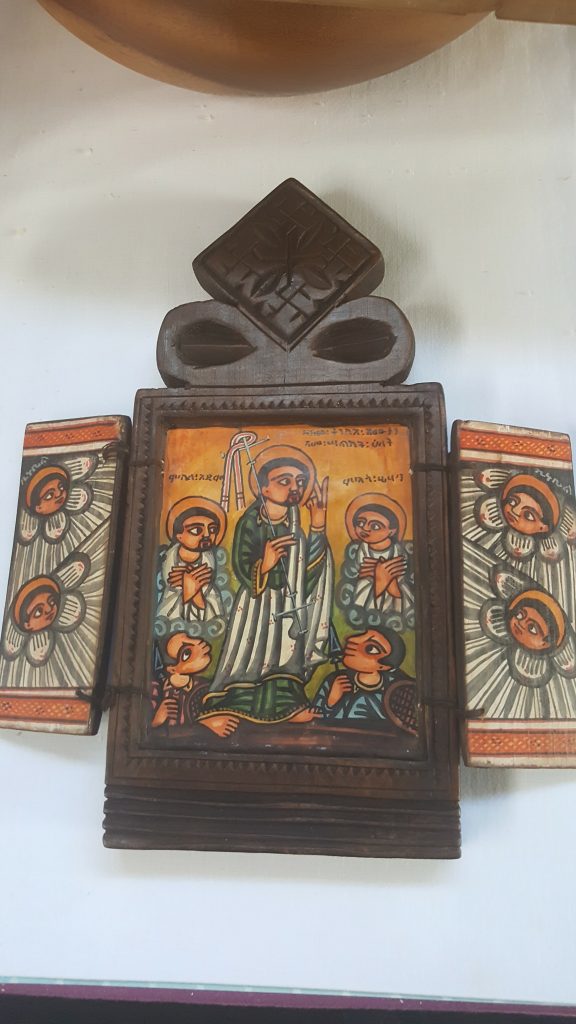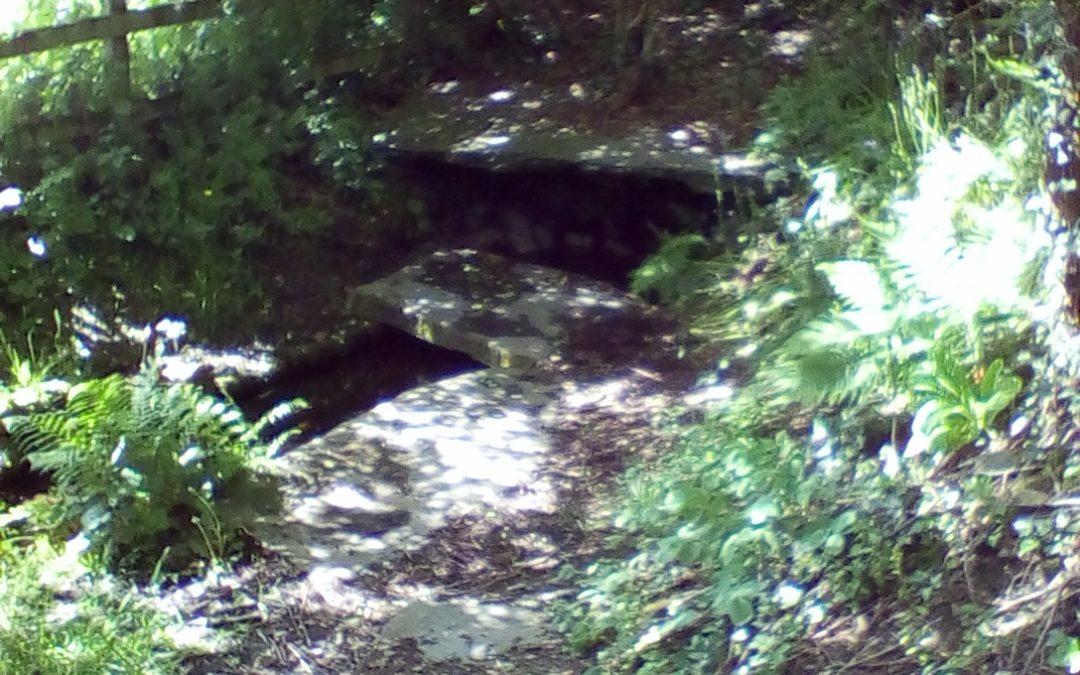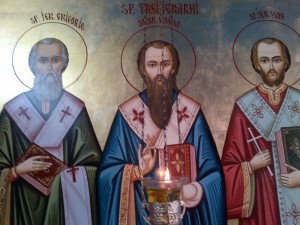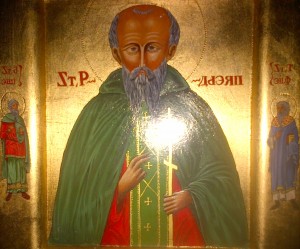Help needed
Can anybody help identify this icon found by Fr Timothy in a second hand shop in Aberystwth?

Can anybody help identify this icon found by Fr Timothy in a second hand shop in Aberystwth?


Liturgy to celebrate the Feast of St Cybi 10.30 followed by ‘ bring and share’ meal.
Blessing of St Cybi’s Well at 15.00hrs

Gwyl Cybi Sant
The sheltered valley of the Nant Tawela (Tawela Brook) is only a few miles from Lampeter, but still, in the 21st century, retains something of the remote and isolated ‘feel’ that it must have possessed for more than a millennium. There has been a Christian presence here since the 5th century. The present church dates only from 1873, but is on an ancient site. (A church was mentioned here in 1281.) It is all but surrounded by early earthworks (best seen from the air!) the church situated within an inner enclosure. Is this possibly the “llan” or sacred space of the settlement founded by St Sulien? The evidence is strong; there are no fewer than three early Christian monuments on the site, one only rediscovered in May, 2013. The earliest, built into the church wall, bears the inscription “Silbandus iacit” – an abbreviation of a familiar Christian grave-marker formula, “Silbandus lies here”. It is accepted that “Silian” (or Sulien, which would have been pronounced in a similar way) is probably an abbreviation of this name, and that Silbandus was the founder of this holy place, to which he had resorted for ‘peace and repentance’.
Sulien is not an uncommon name among early generations of Christians; a St Sulien was the abbot-founder of Luxulyan in Cornwall, and another St Sulien is associated with Cornouaille in Brittany. A third St Sulien is connected, with his brother or cousin St Mael, with Corwen in mid-Wales. One Sulien was bishop of St Davids in the 11th century, and it was his son, Rhigyfarch, who wrote the “Life of St David”. The Sulien or Silbandus of Silian must be added to this illustrious and holy company. The feast days of the saints Sulien are many and various, but a likely date for our local saint is September 2nd. We ask for his prayers.
Surprisingly little is known of Dewi Sant / St David the patron saint of Wales. Much of the information derives from a life written 500 years later in the 11th century by Rhygyfarch one of whose aims was to prove the independence of the Welsh church from the see of Canterbury.
It is likely that he was born near the present city of St David’s in Pembrokeshire. The ruins of an ancient chapel dedicated to his mother, St Non, and his reputed birthplace can be seen in a field near a holy well and the retreat centre of St Non with its more modern chapel. He may have been educated by St Paulinus at Hen Fynyw near Aberaeron.
Rhygyfarch claims that David was consecrated bishop by the Patriarch at Jerusalem together with Padarn and Teilo though there is no evidence of this.
He became known as a teacher and preacher and founded a monastery at St David’s on the site of the present cathedral.
His monastic rule was very strict. The monks had to plough the fields without the aid of animals and were allowed only bread, salt, herbs and vegetables. David became known as Dewi Ddyfrwr (David the waterdrinker) and would pray while standing up to his neck in cold water.
David attended the Synod of Brefi called about 560 where his preaching against Pelagianism impressed his fellow clerics and he may have presided at the Synod of Victory at Caerleon about 569.
David died on March 1st, 589, and among his last words to his fellow monks were “Be joyful, keep the faith and do the little things that you have seen me do.”
Later his shrine in the new Norman cathedral became a place of pilgrimage and the Pope decreed that two pilgrimages to St David’s equalled one to Rome, and three pilgrimages were the equivalent of one to Jerusalem. The shrine was destroyed at the Reformation but bones thought to be those of St David and his friend St Justinian were discovered later and placed behind the High Altar of the cathedral. The reliquary which contained them was presented in the 1920s by Patriarchs of the Orthodox Church. Recent carbon dating has cast doubt on whether the fragments are really those of the saints but nevertheless the original shrine, in the north of the sanctuary, has been restored in recent years.
Troparion (tone 8)
Orthodoxy’s guide, Teacher of piety and reverence, Pastor of Menevia, greatest protector of all
Wales. Wonderworker David, by your teaching you have enlightened all, O Herald of grace.
Intercede with Christ God, that our souls may be saved.
Kontakion (tone 6)
The living waters of godly discipline encompassed you and the saving waters of faith flowed
through your teaching, O Hierarch and waterman David. Symbolising the baptism of Wales in
your life, you are worthy of all praise. Wherefore we keep festival in your honour, glorifying
your eternal memory.
ST ELUNED
A late seventeenth account by Breconshire Herald, Hugh Thomas (Harleian MS 4,181) says:
“S. Lhud, that is anger; she is commonly called S. Alud or Aled, but Giraldus Cambrensis calls her Almedha … It seems that having from her infancy dedicated herself solely to the service of God, in her riper years, being violently pressed by a young prince to marriage, to free herself from his solicitations and those of her family, she secretly stole away from her father’s house in a disguise, resolving for a time to conceal herself in the neighbouring villages … The first she retired to was the village of Llandew, where she was so ill treated that, fleeing from hence she retired to a village called Llanfilo, three miles further, to live in greater obscurity, which, joined with her poverty, beauty in rags, was the cause she was treated as a common thief. From thence, fleeing back again to another village called Llechfaen, within a mile of Brecknock, where she was treated with such scorn and contempt that nobody would receive her, but forced her to lie in the street and the high road, which ever since is called of her name in Welsh, Heol S. Alud. After which she resolved to retire to some solitude, never more to converse with mortals; and such a solitude she found upon a hill called the Slwch … near the town of Brecknock, which was then overgrown with wood. Here, that she might receive no further insults, she desired the Lord of the Manor to give her leave to dwell, which was very courteously granted, with a promise of other charity, upon which she there built her a little cell or oratory and was used often to go down to the Castle of the Slwch to beg for bread, where she was very hospitably received.
“When her thoughts were settled in a little tranquility after all these storms, by way of prophecy she said: That by the secret judgment of God a chastisement would rest on the village of Llandew for the injuries done to her; that the village of Llanfilo would be plagued with thieves, as they are to this day above all others, and the village of Llechfaen with envy, as indeed they are almost continually in contention and law with one another.
“But this sweetness did not last long; her importunate lover went to her retirement where, finding her alone at prayers, a violent fear surprised her soul, so that she sought to flee down to the Lord’s house at the bottom [of the hill], which the young Prince perceiving, mad with rage and despair, pursues her, cuts off her head which, rolling a little down the hill, a clear spring of water issued out of the rock where it rested. This being presently known, she was taken up and buried in her own little cottage, which was thereupon turned into a chapel.”
Giraldus Cambrensis. writing at the end of the twelfth century, says:
“In her honour a solemn feast is annually held here [in her chapel] in the beginning of August, and attended by a large concourse of people from a considerable distance, when those persons who labour under various diseases, through the merits of this blessed virgin, receive their wished-for health. The circumstances which occur at every anniversary appear to me remarkable. You may see men or girls, now in the church, now in the churchyard, now in a dance, which is led round the churchyard with a song, on a sudden falling on the ground as in a trance, then jumping up as in a frenzy, and representing with their hands and feet. before the people, whatever work they have unlawfully done on feast days; you may see one man put his hand to the plough, and another, as it were, goad on the oxen, mitigating their sense of labour by the usual rude song; one man imitating the profession of a shoemaker; another that of a tanner. You may see a girl with a distaff, drawing out the thread, and winding it again on the spindle; another walking and arranging the threads for the web; another, as it were, throwing the shuttle and seeming to weave. On being brought into the church, and led up to the altar with their oblations, you will be astonished to see them suddenly awakened and coming to themselves. Thus, by the divine mercy, which rejoices in the conversion – not in the death – of sinners, many persons, from the conviction of their senses, are at these feast days corrected and amended.”
The photographs show
The ‘Slwch tump’ – an iron age fort where we think Eluned had her cell.
Abbot of Bangor (c. 584).
In Welsh-Deiniol, in Latin-Dainiolus and in English-Daniel.
Deiniol, born in the early 6th century, was an important figure in the development of Christianity in North Wales. The son of a Celtic chieftain, he founded two monasteries, both named Bangor, one of which was close to the modern town of that name…
A drawing of the old church of Llanerfyl in Montgomeryshire, Wales, dating from before 1870 when the building was demolished and replaced by the present structure, shows a huge and spreading yew tree in the churchyard. Beneath the tree can be seen what is now known to be an early Christian grave marker. (The stone has now been taken into the church to prevent erosion.) It was long thought to mark the earthly resting-place of St Erfyl, but this is now known not to be the case. Although much worn, the inscription has been interpreted to reveal that it marked the grave of Rustica, the thirteen-year old daughter of Paterninus. The inclusion of the word ‘peace’ in the inscription tells us that Paterninus and his daughter were Christians. The stone has been dated to the 5th or 6th Christian centuries, and shows us that there was a Christian presence here by that time. That fits well with the presumed dates of the life of the church’s patron, the virgin St Erfyl, who is believed to have settled here in what was then a remote and peaceful spot for a life of contemplation and prayer.
What is exciting about Llanerfyl is the survival in the church of two remarkable pieces of woodwork, both dating from the 15th century. The first is the skeletal remains of an elegant canopied shrine, which no doubt formed the centrepiece of the altar. In the base are two mortice-holes, which once anchored statues. One would have been of the Theotokos and Child, the other of St Erfyl. It is clear that the shrine originally had a pair of doors, which would have had painted panels depicting the lives of the Theotokos and Erfyl, and which would have been closed during Great Lent. Neither the statues nor the doors have survived.
The second item is a reliquary, carved in the shape of a church. This would have contained the casket which housed the relics of the saint. The reliquary thus formed a tabernacle – what was known as a capsula reliquiarum – and this would have been carried in processions. The slots for the carrying-poles survive. These two items of sacred furniture vividly evoke the days when the Holy Virgin and St Erfyl were venerated locally.
As with so many early Christian sites in Wales, there was a holy well nearby. It has now dried up, and its stone arched canopy has disappeared. For many centuries the water from the well was used for all baptisms in the church, and on the Sunday after the feast-day of St Erfyl (variously the 5th or 6th July in the old calendars) and on Easter Monday the youth of the community gathered at the well to drink of the waters, sweetened with sugar, and then enjoyed a picnic and dance in the field surrounding.
There are several variant spellings of the name Erfyl. One is Eurfyl, and it has been suggested that this means “she of the golden lips”. Are there echoes here of the saintly John Chrysostom, the “golden tongued”?
The church of the Three Hierarchs and St Cybi here in Lampeter houses a Holy Icon containing a relic of St Erfyl. There is an early 20th century stained-glass window in Llanerfyl Church depicting the saint, holding a model of the church she founded so many centuries ago.
Holy Erfyl, pray for us.
The Dedication of the Orthodox Church in Lampeter is to the Three Hierarchs or luminaries of the Church:

Basil the Great, Gregory the Theologian and John Chrysostom
Basil the Great, Gregory the Theologian and John Chrysostom.
As great Bishops and teachers of the Orthodox Faith, who laboured to expound the Gospels and teachings of the Church they are honoured as men of extraordinary learning and discernment. (more…)

St Padarn
St Padarn
Padarn was born in the late 5th century in Brittany. His parents were devout Christians and Padarn decided to devote himself to a life of prayer and fasting. (more…)
Recent Comments